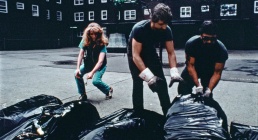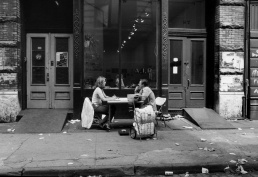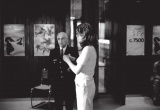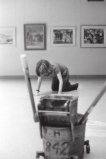Difference between revisions of "Mierle Laderman Ukeles"
| (One intermediate revision by the same user not shown) | |||
| Line 1: | Line 1: | ||
| + | [[Image:Ukeles_Mierle_Laderman_1979_Touch_Sanitation_Performance.jpg|thumb|258px|Ukeles, with two unidentified workers, in ''Touch Sanitation Performance,'' which took eleven months, beginning in July 1979.]] | ||
| + | [[Image:Ukeles_Mierle_Laderman_1973-74_Interviewing_Passersby_on_the_Sidewalk_about_Their_Maintenance_Lives.jpg|thumb|258px|Ukeles, ''Interviewing Passersby on the Sidewalk about Their Maintenance Lives'', 1973-74. Outside A.I.R. Gallery, New York. Part of the ''Maintenance Art Tasks'' series.]] | ||
'''Mierle Laderman Ukeles''' (1939, Denver, Colorado) is a New York City-based artist. | '''Mierle Laderman Ukeles''' (1939, Denver, Colorado) is a New York City-based artist. | ||
| − | The work of Ukeles concerns the everyday routines of life. In 1969, following the birth of her first child, Ukeles wrote her | + | The work of Ukeles concerns the everyday routines of life. In 1969, following the birth of her first child, Ukeles wrote her ''Manifesto for Maintenance Art'' as a challenge to the oppositions between art and life, nature and culture, and public and private. Her work looked to highlight otherwise overlooked aspects of social production and questions, still very relevant today, the hierarchies of different forms of work, especially of housework and low-wage labour. Ukeles was interested in how artists could use the concept of transference to empower people to act as agents of change and stimulate positive community involvement toward ecological sustainability. [https://www.arnolfini.org.uk/whatson/mierle-laderman-ukeles-maintenance-art-works-196920131980] |
| − | "I am an artist. I am a woman. I am a wife. I am a mother. (Random order). I do a hell of a lot of washing, cleaning, cooking, renewing, supporting, preserving, etc. Also, (up to now separately) I 'do' Art. Now I will simply do these everyday things, and flush them up to consciousness, exhibit them, as Art." | + | <blockquote>"I am an artist. I am a woman. I am a wife. I am a mother. (Random order). I do a hell of a lot of washing, cleaning, cooking, renewing, supporting, preserving, etc. Also, (up to now separately) I 'do' Art. Now I will simply do these everyday things, and flush them up to consciousness, exhibit them, as Art."<br> |
| − | (Ukeles, Manifesto for Maintenance Art, 1969). | + | (Ukeles, ''[[#Manifesto|Manifesto for Maintenance Art]]'', 1969).</blockquote> |
| + | |||
| + | Ukeles’s early ''Maintenance Art Tasks'' (1973) explores the complexity, duration, and choreography of daily maintenance activities by documenting them in detail: hair cuts, doctors visits, changing diapers, and washing dishes among others. The numerous images of a single activity indicate the extended time span that maintenance requires. In ''Touch Sanitation'' (1979-80), Ukeles shook the hands of and personally thanked all of the approximately 8,500 sanitation workers in the New York City department of sanitation. Engaging in public space, ''Touch Sanitation'' humanizes this alienating work and conveys the importance of a traditionally devalued sector of labor. As the project progressed, she also documented the stories of these workers in the video ''Sanman Speaks'' (1979-84), providing a space for the workers to articulate their own positions and experiences. The video also records the complex and durational process of collecting and disposing of waste, giving a sense of the physical immensity of society’s refuse. In the performance ''Maintaining NYC in Crisis: What Keeps NYC Alive?'' (1976), Ukeles reads the job titles of those in municipal bureaucracies threatened by the city’s impending bankruptcy but necessary to keep the the city functioning, a recitation that can be read as both a living memorial and a declarative protest. [https://sculptureatpratt.files.wordpress.com/2016/09/pages-from-mlu-manifesto-maintenance-art.pdf] | ||
| + | |||
| + | Since 1977, Ukeles has acted as artist in residence at the New York City Department of Sanitation and realised radical public art as public culture in a system which serves and is owned by the entire population. | ||
| + | |||
| + | |||
| + | <gallery> | ||
| + | Ukeles_Mierle_Laderman_1979-80_Touch_Sanitation_Performance_Sweep_7_Staten_Island_6_00_am_Roll_Call.jpg|Ukeles, ''Touch Sanitation Performance: Sweep 7, Staten Island, 6:00 a.m. Roll Call'', 1979-80. Citywide performance with 8,500 New York City sanitation workers. | ||
| + | Ukeles Mierle Laderman 1973 The Keeping of the Keys Maintenance as Security.jpg|Ukeles, ''The Keeping of the Keys: Maintenance as Security'', 1973. Three-hour performance, c. 7,500, Wadsworth Atheneum, Hartford, Ct, July 20, 1973. Part of the ''Maintenance Art Tasks'' series. | ||
| + | Ukeles Mierle Laderman 1973 Hartford Wash Washing Tracks Maintenance Inside.jpg|Ukeles, ''Hartford Wash: Washing/Tracks/Maintenance: Inside'', 1973. Performance view, c. 7,500, Wadsworth Atheneum, Hartford, Ct, July 22, 1973. Part of the ''Maintenance Art Tasks'' series. | ||
| + | </gallery> | ||
; Writings | ; Writings | ||
| − | * [https://www.arnolfini.org.uk/blog/manifesto-for-maintenance-art-1969 "Manifesto for Maintenance Art"], 1969. | + | * {{a|Manifesto}} [https://www.arnolfini.org.uk/blog/manifesto-for-maintenance-art-1969 "Manifesto for Maintenance Art"], 1969. |
; Recent exhibitions | ; Recent exhibitions | ||
Revision as of 20:54, 22 November 2017
Mierle Laderman Ukeles (1939, Denver, Colorado) is a New York City-based artist.
The work of Ukeles concerns the everyday routines of life. In 1969, following the birth of her first child, Ukeles wrote her Manifesto for Maintenance Art as a challenge to the oppositions between art and life, nature and culture, and public and private. Her work looked to highlight otherwise overlooked aspects of social production and questions, still very relevant today, the hierarchies of different forms of work, especially of housework and low-wage labour. Ukeles was interested in how artists could use the concept of transference to empower people to act as agents of change and stimulate positive community involvement toward ecological sustainability. [1]
"I am an artist. I am a woman. I am a wife. I am a mother. (Random order). I do a hell of a lot of washing, cleaning, cooking, renewing, supporting, preserving, etc. Also, (up to now separately) I 'do' Art. Now I will simply do these everyday things, and flush them up to consciousness, exhibit them, as Art."
(Ukeles, Manifesto for Maintenance Art, 1969).
Ukeles’s early Maintenance Art Tasks (1973) explores the complexity, duration, and choreography of daily maintenance activities by documenting them in detail: hair cuts, doctors visits, changing diapers, and washing dishes among others. The numerous images of a single activity indicate the extended time span that maintenance requires. In Touch Sanitation (1979-80), Ukeles shook the hands of and personally thanked all of the approximately 8,500 sanitation workers in the New York City department of sanitation. Engaging in public space, Touch Sanitation humanizes this alienating work and conveys the importance of a traditionally devalued sector of labor. As the project progressed, she also documented the stories of these workers in the video Sanman Speaks (1979-84), providing a space for the workers to articulate their own positions and experiences. The video also records the complex and durational process of collecting and disposing of waste, giving a sense of the physical immensity of society’s refuse. In the performance Maintaining NYC in Crisis: What Keeps NYC Alive? (1976), Ukeles reads the job titles of those in municipal bureaucracies threatened by the city’s impending bankruptcy but necessary to keep the the city functioning, a recitation that can be read as both a living memorial and a declarative protest. [2]
Since 1977, Ukeles has acted as artist in residence at the New York City Department of Sanitation and realised radical public art as public culture in a system which serves and is owned by the entire population.
- Writings
- Recent exhibitions
- Mierle Laderman Ukleles, Maintenance Artworks: 1969-1980, Arnolfini, Bristol, 2013.
- Mierle Laderman Ukleles: Maintenance Art, Queens Museum, 2017. Review: Metropolis M.
- Links




